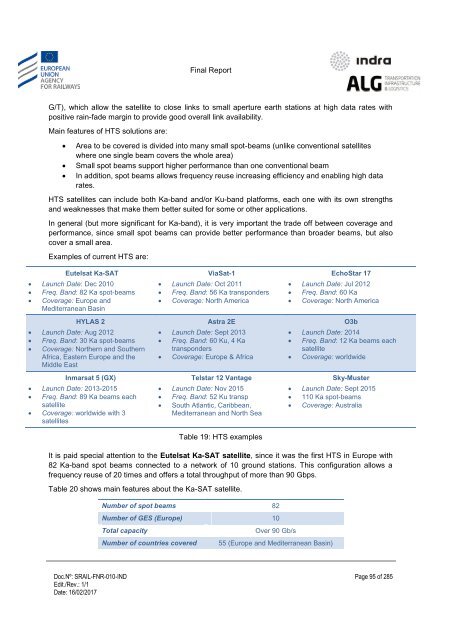Study on feasibility of SATCOM for railway communication
SRAIL-FNR-010-IND%20-%20FinalReport_v1.1_20170216
SRAIL-FNR-010-IND%20-%20FinalReport_v1.1_20170216
Create successful ePaper yourself
Turn your PDF publications into a flip-book with our unique Google optimized e-Paper software.
Final Report<br />
G/T), which allow the satellite to close links to small aperture earth stati<strong>on</strong>s at high data rates with<br />
positive rain-fade margin to provide good overall link availability.<br />
Main features <strong>of</strong> HTS soluti<strong>on</strong>s are:<br />
<br />
<br />
<br />
Area to be covered is divided into many small spot-beams (unlike c<strong>on</strong>venti<strong>on</strong>al satellites<br />
where <strong>on</strong>e single beam covers the whole area)<br />
Small spot beams support higher per<strong>for</strong>mance than <strong>on</strong>e c<strong>on</strong>venti<strong>on</strong>al beam<br />
In additi<strong>on</strong>, spot beams allows frequency reuse increasing efficiency and enabling high data<br />
rates.<br />
HTS satellites can include both Ka-band and/or Ku-band plat<strong>for</strong>ms, each <strong>on</strong>e with its own strengths<br />
and weaknesses that make them better suited <strong>for</strong> some or other applicati<strong>on</strong>s.<br />
In general (but more significant <strong>for</strong> Ka-band), it is very important the trade <strong>of</strong>f between coverage and<br />
per<strong>for</strong>mance, since small spot beams can provide better per<strong>for</strong>mance than broader beams, but also<br />
cover a small area.<br />
Examples <strong>of</strong> current HTS are:<br />
Eutelsat Ka-SAT<br />
Launch Date: Dec 2010<br />
Freq. Band: 82 Ka spot-beams<br />
Coverage: Europe and<br />
Mediterranean Basin<br />
HYLAS 2<br />
Launch Date: Aug 2012<br />
Freq. Band: 30 Ka spot-beams<br />
Coverage: Northern and Southern<br />
Africa, Eastern Europe and the<br />
Middle East<br />
Inmarsat 5 (GX)<br />
Launch Date: 2013-2015<br />
Freq. Band: 89 Ka beams each<br />
satellite<br />
Coverage: worldwide with 3<br />
satellites<br />
ViaSat-1<br />
Launch Date: Oct 2011<br />
Freq. Band: 56 Ka transp<strong>on</strong>ders<br />
Coverage: North America<br />
Astra 2E<br />
Launch Date: Sept 2013<br />
Freq. Band: 60 Ku, 4 Ka<br />
transp<strong>on</strong>ders<br />
Coverage: Europe & Africa<br />
Telstar 12 Vantage<br />
Launch Date: Nov 2015<br />
Freq. Band: 52 Ku transp<br />
South Atlantic, Caribbean,<br />
Mediterranean and North Sea<br />
Table 19: HTS examples<br />
EchoStar 17<br />
Launch Date: Jul 2012<br />
Freq. Band: 60 Ka<br />
Coverage: North America<br />
O3b<br />
Launch Date: 2014<br />
Freq. Band: 12 Ka beams each<br />
satellite<br />
Coverage: worldwide<br />
Sky-Muster<br />
Launch Date: Sept 2015<br />
110 Ka spot-beams<br />
Coverage: Australia<br />
It is paid special attenti<strong>on</strong> to the Eutelsat Ka-SAT satellite, since it was the first HTS in Europe with<br />
82 Ka-band spot beams c<strong>on</strong>nected to a network <strong>of</strong> 10 ground stati<strong>on</strong>s. This c<strong>on</strong>figurati<strong>on</strong> allows a<br />
frequency reuse <strong>of</strong> 20 times and <strong>of</strong>fers a total throughput <strong>of</strong> more than 90 Gbps.<br />
Table 20 shows main features about the Ka-SAT satellite.<br />
Number <strong>of</strong> spot beams 82<br />
Number <strong>of</strong> GES (Europe) 10<br />
Total capacity<br />
Number <strong>of</strong> countries covered<br />
Over 90 Gb/s<br />
55 (Europe and Mediterranean Basin)<br />
Doc.Nº: SRAIL-FNR-010-IND<br />
Edit./Rev.: 1/1<br />
Date: 16/02/2017<br />
Page 95 <strong>of</strong> 285


